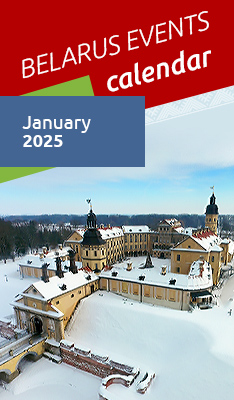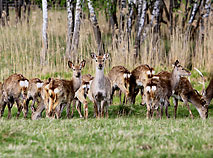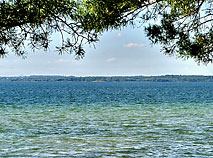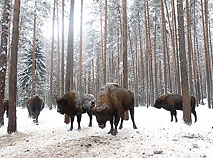Ecotourism in Belarus

With its fabulous natural beauty, primeval forests and marshlands, crystal-clear lakes and rivers, a great diversity of flora and fauna, Belarus is certainly a must-see for eco-tourists.
The first environmental protection laws were introduced in Belarus by the Statute of the Grand Duchy of Lithuania as early as the 16th century. Due to this, vast areas of land in today’s Belarus remained intact. By the way, Belovezhskaya Pushcha, Europe’s biggest forest, was declared a reserve by Grand Duke of Lithuania Jahajla over 600 years ago.
In the 21st century, nature remains one of Belarus’ biggest assets. Eco-tourists are invited to visit the famous national parks and reserves, wildlife sanctuaries, natural monuments and simply picturesque places that are abundant all over the country. There are plenty of things that will make them stand and stare.
For example, Belarus is home to some of Europe’s biggest and deepest lakes that were left by ancient glaciers. Belarusian bogs, many of which are absolutely unique, are by right considered the "lungs" of the continent…
The country’s symbol – bison – is the heaviest and biggest land mammal in Europe. At present Belarus is ranked second in terms of the bison population. Since 1946 these stately animals have been protected by the state.
Ornithologists come to Belarus from all over the world to watch birds: one will be able to see thousands of different birds at a time in Pripyatsky National Park and Berezina Biosphere Reserve. Belarus is a stronghold of aquatic warbler where 60% of its world’s population breeds.
White stork is one of the most popular and loved birds in Belarus, as this bird symbolizes happiness, well-being, health and revival. One can spend hours watching them flying in the sky, strolling in the field, taking care of the offspring in nestles…
Belarus is a great destination for outdoor lovers, with a plenty of opportunities to experience an adventure in nature. One can go hiking, biking or horse riding along an eco-route, order a mini-tour on a steamboat or a boat, take part in an eco-safari watching wild animals in their natural habitat, or simply contemplate the surrounding natural beauty in silence.
Eco-tourists are invited to stay at one of many eco-farms all over Belarus. These farms are built from eco-friendly materials in remote locations and their residents are offered a variety of outdoor entertainments, eco-friendly and fresh farm produce.
National parks and reserves
There are four national parks and two reserves in Belarus:
-
Belovezhskaya Pushcha National Park
-
Braslav Lakes National Park
-
Pripyatsky National Park
-
Narochansky National Park
-
Polesie Radiation and Ecological Reserve
Excursions at the Belarusian national parks and the biosphere reserve are both a highly educational and entertaining experience.
For example, Narochansky National Park, famous for its amazing landscapes, offers diving and helicopter rides. Visitors to Pripyatsky National Park can go on a safari trip in the primeval "Belarusian Amazonia".
In Belovezhskaya Pushcha, tourists can look into the "wilderness" at sunrise or before sunset, or take a unique route "Pushcha's Robinsons". In the vicinity of Braslav they can admire the "necklace" of large and small glacial lakes.
In addition to major national parks and reserves there are more than a thousand protected areas in Belarus:
-
85 sanctuaries of the national importance and 248 of local significance;
-
306 natural monuments of the state level and 576 of regional level.
Therefore, there are a lot of interesting places for ecotourism enthusiasts to study and recreate. Among them, for example are:
-
the biological reserve Sporovsky – Belarus’ first Ramsar site (the home ground of the national scything championship);
-
the landscape reserve Olmany Mires, Europe's largest one-piece forest and lowland complex that is included in the Ramsar List (in the autumn the reserve holds the cranberry festival);
-
the biological reserve Zvanets, the largest lowland with mineral islands, home to 125 bird species (21 from the Red Book List of Endangered Species);
-
the reserve Yelnya, one of the biggest arrays of ancient glacial lakes and bogs in Central and Western Europe (its tourism brand – the festival "Cranes and Cranberries of the Miory Region");
-
the reserve Middle Pripyat (the flood bed of the famous Polesye river is often referred to as European Amazonia).
By the way, the international status of the Ramsar site has been awarded to 26 specially protected territories of Belarus: the reserves Olmany Mires, Sporovsky, Mid-Pripyat, Zvanets, Prostyr, Kotra, Osveiski, Yelnia, Vydritsa, Kozyansky, Vigonoshchanskoe, Morochno, Stary Zhaden, Duleby Islands-Zaozerye, Dnieper River Floodplain, Polesye Valley of River Bug, Servech, Vileity, Iput River Floodplain, Golubickaya Puscha, Podvelikiy Moh, Svislochsko-Berezinsky, Berezinsky Biosphere Reserve and the Pripyatsky National Park.
Eco-Trails and Safari Parks
In Belarus there are many interesting tourist eco-trails and routes stretching from 1 to 250km. Some of them can be covered on foot, others by bike, horse or car, or a motor boat, a rowing boat or a canoe.
In addition, there are also combined routes that combine different types of travel, but above all, they offer interesting attractions for tourists: unique natural areas and objects, monuments of history and architecture, museums and the ancestral estates of famous personalities.
Here are just some of the fascinating environmental trails of Belarus:
-
Secrets of The Ubortskoe Polesye
-
The nature and history of Gomel Oblast (175 km)
-
Cherikov water excursion on the Ptich River (designed for three days)
-
Forbidden Forest Track and an unusual ecological and mythological route In the Land of Myths in Berezinsky Biosphere Reserve
-
Bison Nursery in the Pripyatsky National Park (4km long)
-
Volozhin Presents (150km long)
-
The tourist route around medicinal herbs garden in the Narochansky National Park
-
Myths and Legends of the Land of Life-Giving Springs (250km long)
Belarus, a country of forests, swamps and rivers with abundant wildlife, is interesting for the fans of safari and photo-hunting. During one tour it is possible to see not only all the animals of the "Belarusian five" (bison, wild boar, elk, red deer and wolf) but many other representatives of the European fauna.
Entertaining safari tours are offered on the vast territories of the Belovezhskaya Pushcha and Pripyatsky national parks. Such tours will be available in every national park of Belarus in the future. The development of a safari park is underway in the Narochansky national park as part of the state program.
A safari park will also be set up in the Stankovo eco-tourism center (Dzerzhinsk District) near Minsk: the center will provide an opportunity to come face to face with animals and birds that live on the area exceeding 300 hectares.
An unusual safari park operates in Mogilev, where Belarus’ only educational zoological garden is located. The area of 120 hectares with fields and forests, glacial canyons and ponds is home to about 200 species. An open train will take you on a journey around the park to see animals living in the area.
In 2015 Belarus’ first spring water ecology center Golubaya Krinitsa was set up in Mogilev Oblast.
Eco Festivals and Feasts
Eco festivals that have been recently gaining popularity in Belarus combine the beauty of the nature, rich historical heritage and original folk traditions. Among them are:
-
Cranes and Cranberries of the Miory Region eco festival
Every September one of Europe’s biggest highmoors, Yelnya in Miory District (Vitebsk Oblast), welcomes 5,000 to 7,000 grey cranes that fly to warm countries for winter. The highmoor itself is known for bountiful harvests of health-giving cranberry. Guests of the festival Cranes and Cranberries of the Miory Region have an opportunity to watch these wonderful birds and take pictures, learn a lot of interesting things about the nature and its inhabitants, taste unusual dishes with cranberries. The visit center of the wildlife reserve Yelnya offers tourists binocular glasses and telescopes, bikes, skis, cross-country vehicles, interactive stands and games. An ecological trail (1.5km) is developed on the highmoor. Snowshoe walking on the quagmire is already available.
-
Festival Myths in the Swamp in Berezinsky Biosphere Reserve
Every year in November one of the most famous places in Belarus – Berezinsky Biosphere Reserve – plays host to a festival, which surprises visitors not only with the beauty and uniqueness of nearby nature but also with the mysterious atmosphere of Belarusian myths. The guests are welcomed by the swamp spirit Bolotnik, which is a symbol of the reserve, as well as other creatures and spirits – Tsmok, Pushchevik, Bagnik, Polevik, Arzhavennik, and mermaids… During the festival the guests are invited to go on day and night (!) sightseeing tours, to attend exhibitions, master classes on traditional arts and crafts, folk festivals with mythological entertainment programs…
-
Festival of Sandpipers in Turov
The biological reserve Turov Meadow (Zhitkovichi District) is a unique place in terms of the number and species of birds (including those from the endangered-species list) who nest and spend the migration season on the Pripyat. Sandpipers that gave the name to the festival and that have a bronze monument erected in their honor in Turov can be found in large quantities on the local islands.
-
Countryside tourism festival Zaborsky Fest
This farm and ecotourism festival is a trademark of Rossony District, Vitebsk Oblast, where as statistics say there is one lake per 100 residents. The festival features presentations of ecotourism farms, flower and landscape design exhibitions, excursions to the reserve Krasny Bor, boat trips and whitewater rafting.
-
Festival of ethnic and cultural traditions Zov Polesia
The festival is held once in two years in the agro-town of Lyaskovichi on the territory of the Pripyatsky National Park. The participants of the festival present the original culture of the Belarusian Polesye. Apart from concerts, the program of the festival includes fishing competitions, races on traditional Polesye boats, special expos, including in the Museum of Nature.








 print version
print version make home page
make home page add to bookmarks
add to bookmarks












